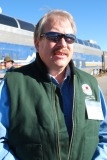The Friends' volunteer work force for Work Session D includes 92 people, many of whom worked during Session C. The Work Session C volunteers ended their tasks early on Friday so they could attend the Friends' annual membership dinner at the Cumbres Pavilion. About 130 Friends' members boarded a charter train at 4:15 p.m., and enjoyed a delicious fried chicken dinner with all of the trimmings, prepared by Osier's Steven Flowers and his staff. Those gathered paid tribute to Spencer Wilson, well known rail historian and pioneer Friends' member, who passed away earlier this year.
The photos we are posting today are focused on a special and unusual project. Team Leader Jim Herron and team member Doug Christensen are working on a project called "Masonry Pointing" at the Lava Pump House. This involves replacing missing mortar in the stones which comprise the Lava Pump House which was erected in 1883. The stone structure has walls that are one-foot thick. There was a smaller pump house at this location before this beautiful stone structure was constructed. Information provided in these captions is information I obtained from Jim and Doug today and I thank them very much.
We will cover all of the on-going projects tomorrow, but of special interest is the completion of the roof paneling on the Antonito Car Storage facility. Team Leader Jim Florey and his talented team report that the last panel was installed on the roof at 10:24 a.m. this morning!
Ted Smith
WORK SESSION D - Monday, June 24 - Part I
First unread post • 5 posts
• Page 1 of 1
Re: WORK SESSION D - Monday, June 24 - Part I
I would guess that since the flattened side is the hinge side of the doorway, they could open the door completely and press it up to the wall.
- John Cole
- Conductor

- Posts: 729
- Joined: Mon Nov 28, 2011 12:55 pm
Re: WORK SESSION D - Monday, June 24 - Part I
Thank you Ted for posting these pics and providing an update. There is a tremendous amount of work being accomplished and I want to thank all those that have been here for work sessions "C" and "D." The completion of the car shelter roof in Antonito looks fantastic.
-

Tim Tennant - Engineer

- Posts: 434
- Joined: Mon Nov 21, 2011 4:04 pm
Re: WORK SESSION D - Monday, June 24 - Part I
WOW, 200+ hits in less than 12 hours! Pretty cool. Do you have any more photos of the car barn you can post? Thanks!
- John Cole
- Conductor

- Posts: 729
- Joined: Mon Nov 28, 2011 12:55 pm
Re: WORK SESSION D - Monday, June 24 - Part I
Fantastic photos! This is one of the few places on the C&T that I have yet to visit.
Jason Rose
<><
Ferroequinearcheologist-in-Training
RioGrandeExplorations.net
Spring, Texas - MP 209.7 - UP Palestine Sub
"All that is necessary for the triumph of evil is that good men do nothing"
"The price of freedom is eternal vigilance" - Wendell Phillips
"Life is tough, but it's tougher when you're stupid." - Sgt Stryker USMC
“Life is too short to deal with other people’s drama.” – Sgt Jason Rose USMC
<><
Ferroequinearcheologist-in-Training
RioGrandeExplorations.net
Spring, Texas - MP 209.7 - UP Palestine Sub
"All that is necessary for the triumph of evil is that good men do nothing"
"The price of freedom is eternal vigilance" - Wendell Phillips
"Life is tough, but it's tougher when you're stupid." - Sgt Stryker USMC
“Life is too short to deal with other people’s drama.” – Sgt Jason Rose USMC
-

Jason Rose - Moderator

- Posts: 2800
- Joined: Thu Nov 17, 2011 1:09 pm
- Location: Spring, Texas (MP 209.7 - UP Palestine Sub)
5 posts
• Page 1 of 1
Return to Work Session D (June 24-28)
Who is online
Users browsing this forum: No registered users and 1 guest

